Abstract
In contrast to the results obtained with ampicillin, the minimum inhibitory concentrations of cefamandole against Haemophilus influenzae were within the same range (0.5 to 1.5 μg/ml) whether or not the strains were beta-lactamase producers. The minimum bactericidal concentrations were somewhat higher for beta-lactamase-positive strains (6.4 μg/ml) than for negative strains (1.2 μg/ml). In a culture with high initial microbial density, monitored by recording optical densities, the addition of 10 μg of cefamandole per ml brought about rapid lysis of a beta-lactamase-negative strain. Observation of a beta-lactamase-positive strain revealed, in the early part of the growth curve, absence of lysis and an increase of biomass similar to that observed in a drug-free control curve. In contrast to the results obtained with ampicillin, the culture consisted uniformly of spherical forms, probably in the process of division, which were capable of generating colonies. When the microbial density exposed to cefamandole was increased still further, persistent bacillary forms were observed, and after 24 h hydrolysis had eliminated every trace of microbiologically active cefamandole.
Full text
PDF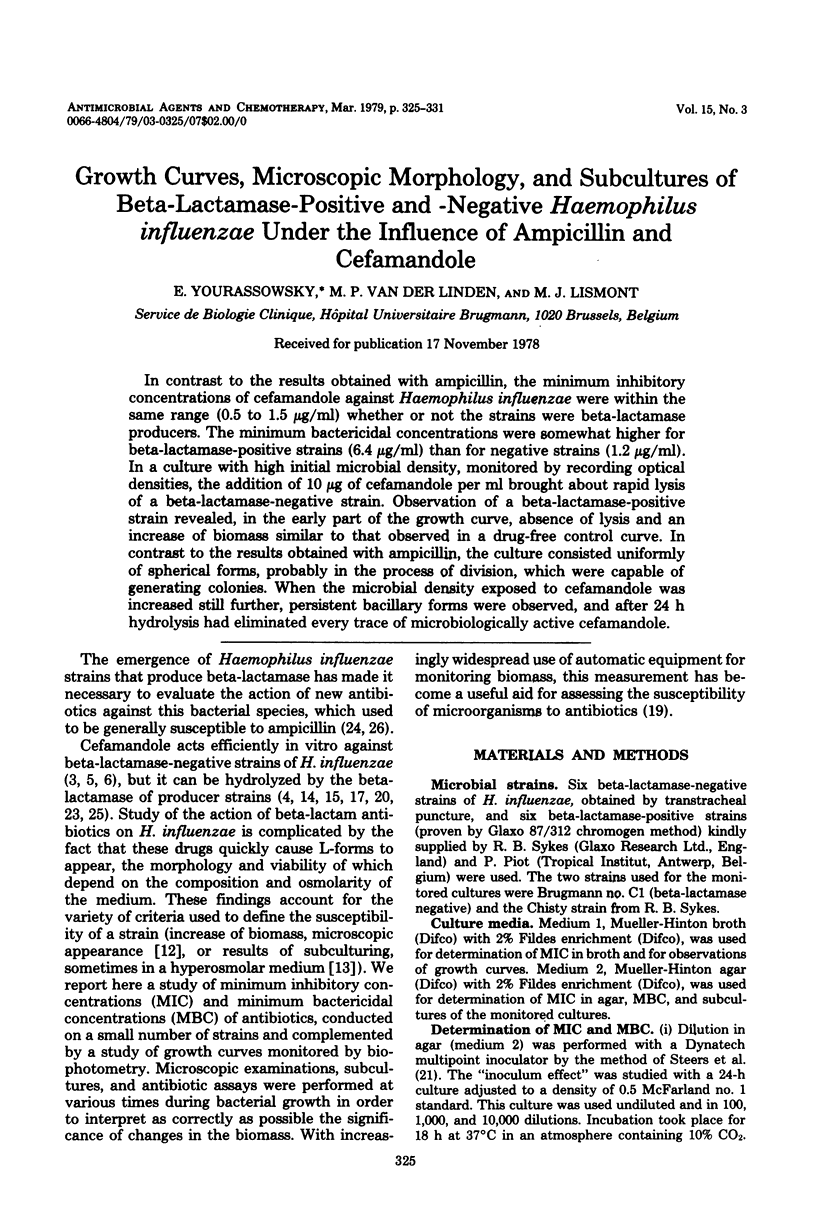
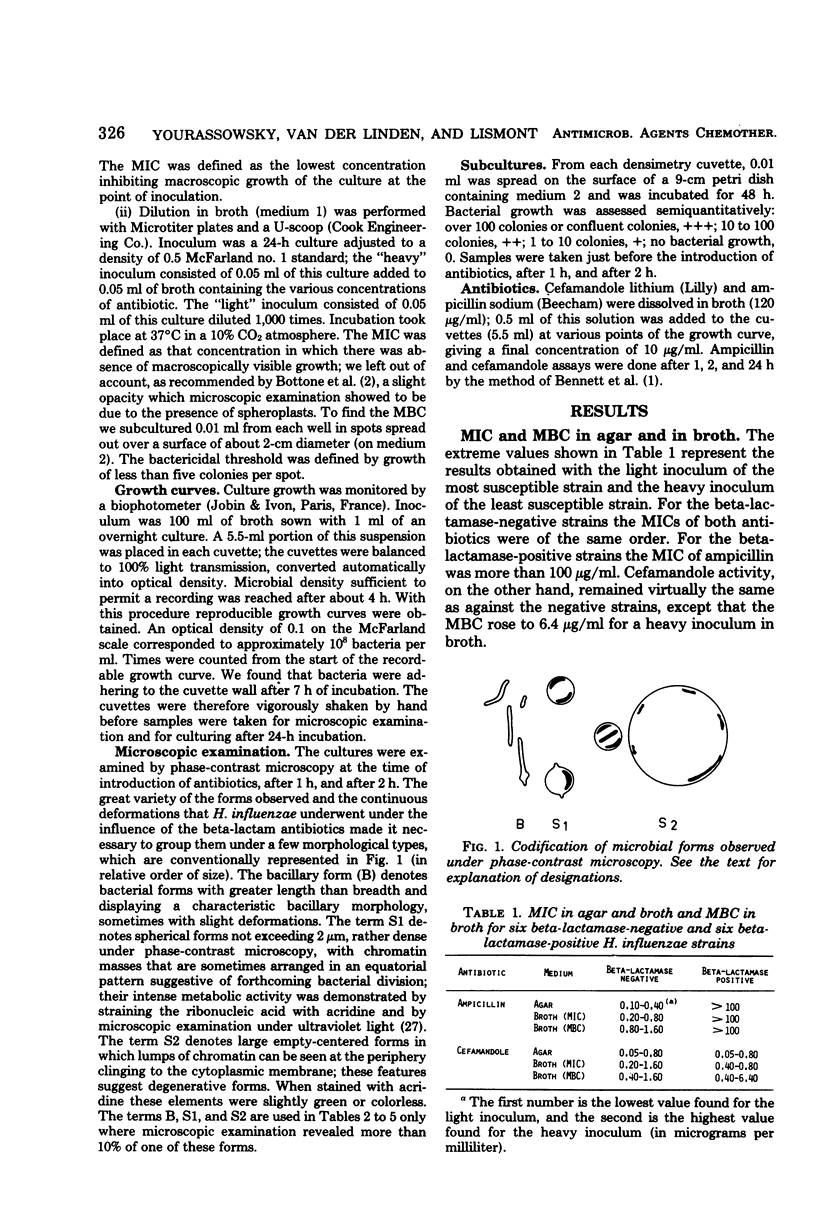
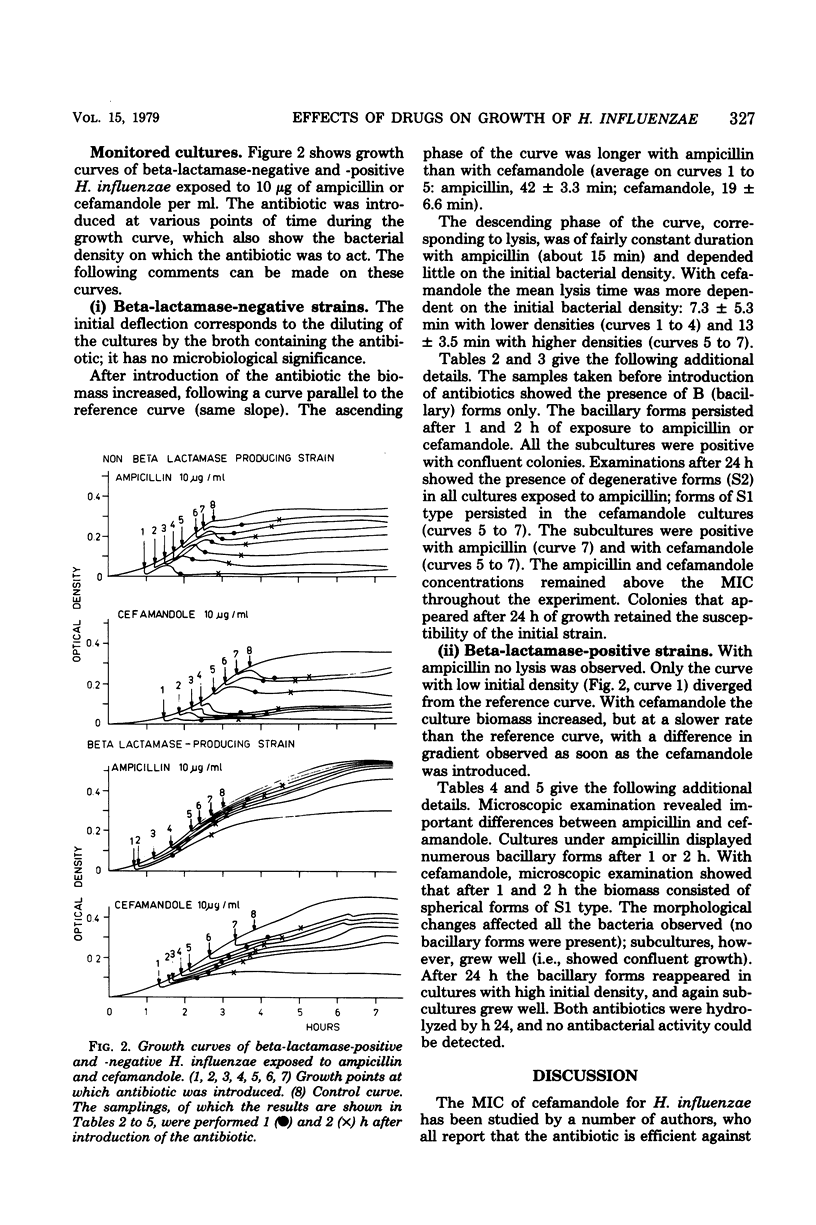
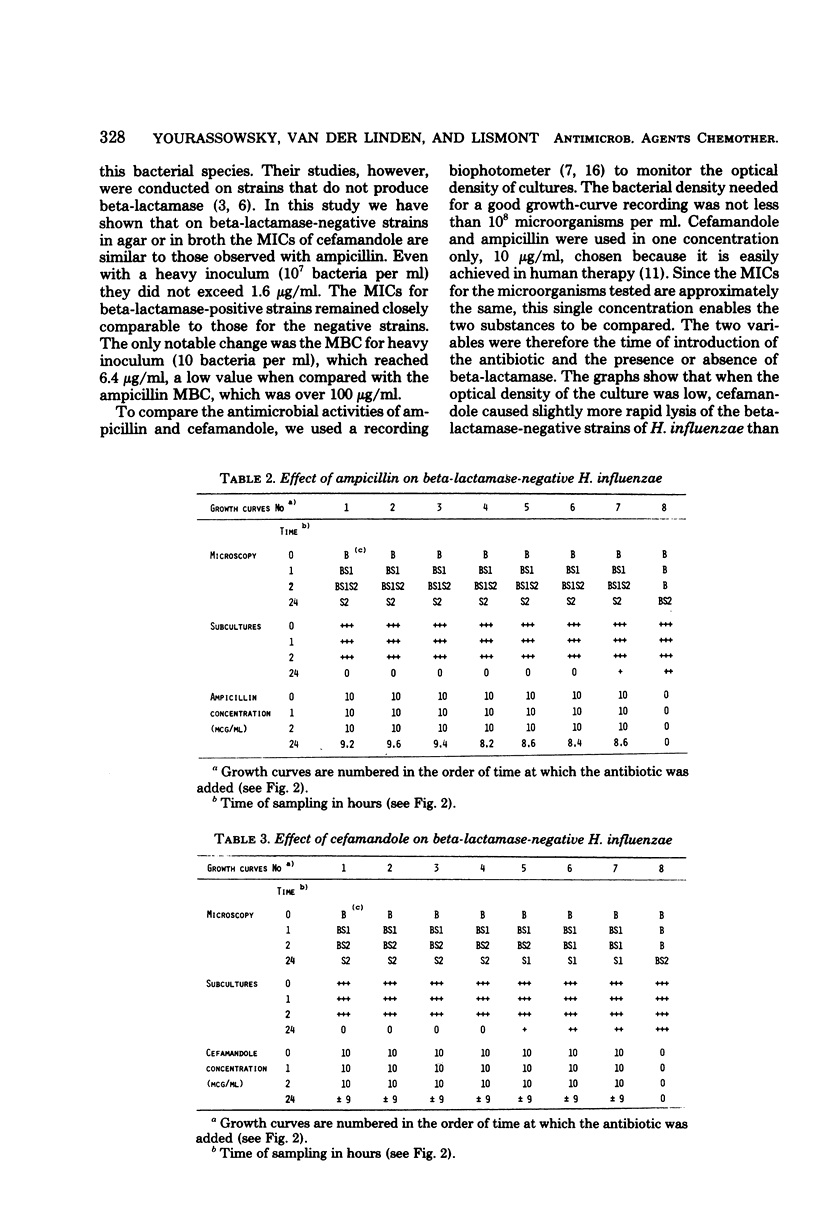
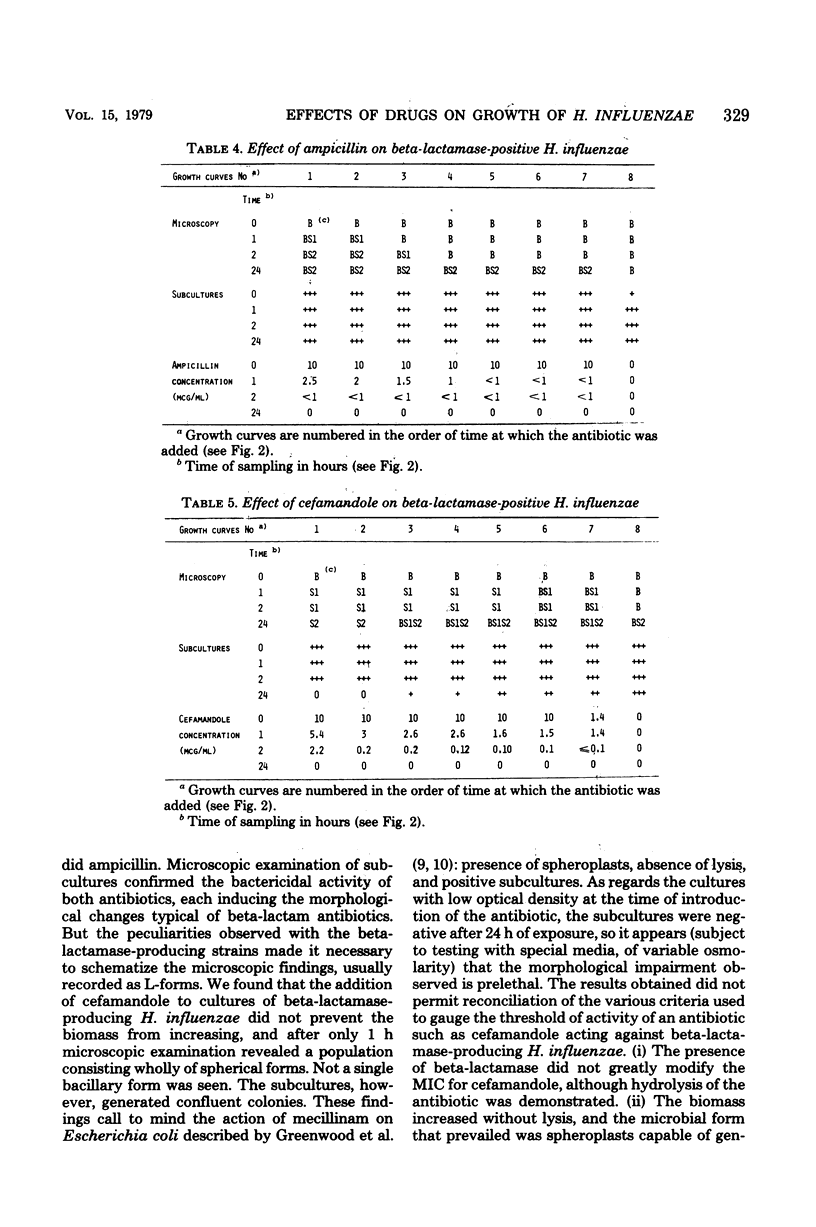
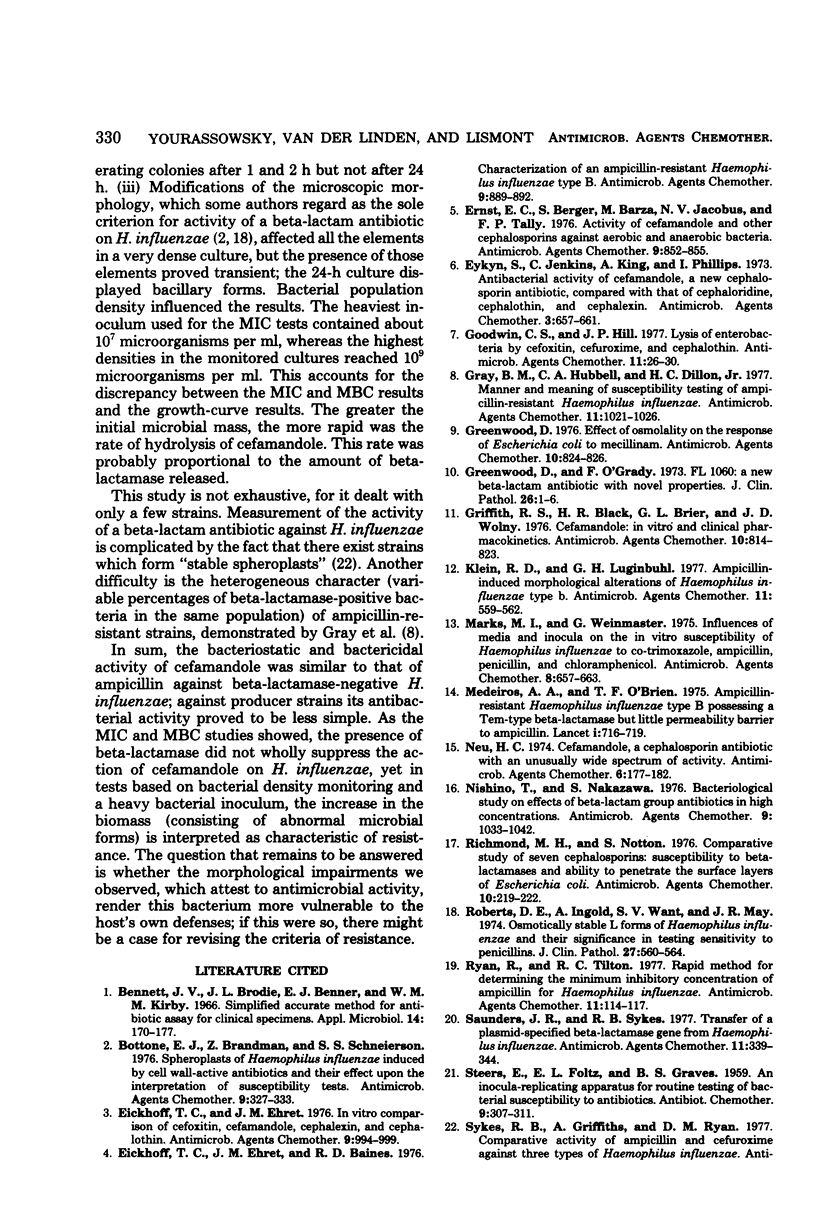
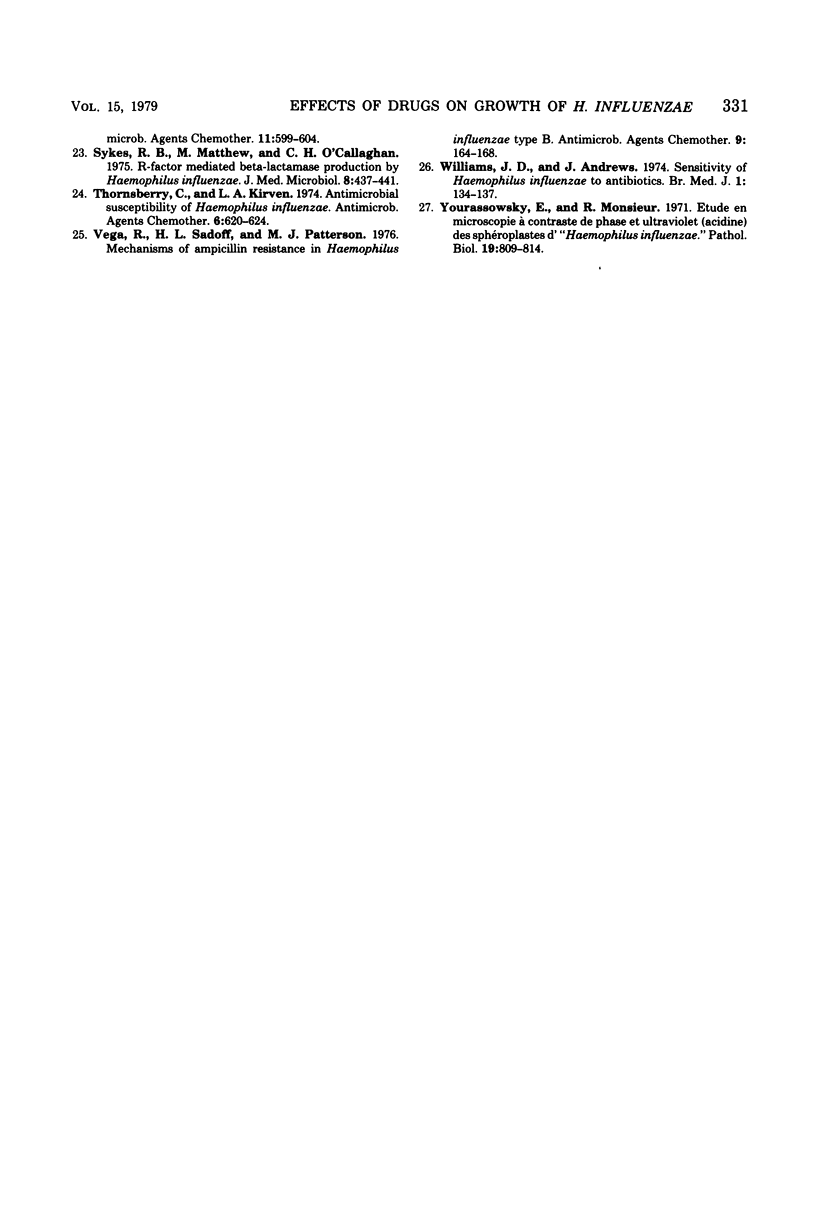
Selected References
These references are in PubMed. This may not be the complete list of references from this article.
- Bennett J. V., Brodie J. L., Benner E. J., Kirby W. M. Simplified, accurate method for antibiotic assay of clinical specimens. Appl Microbiol. 1966 Mar;14(2):170–177. doi: 10.1128/am.14.2.170-177.1966. [DOI] [PMC free article] [PubMed] [Google Scholar]
- Bottone E. J., Brandman Z., Schneierson S. S. Spheroplasts of Haemophilus influenzae induced by cell wall-active antibiotics and their effect upon the interpretation of susceptibility tests. Antimicrob Agents Chemother. 1976 Feb;9(2):327–333. doi: 10.1128/aac.9.2.327. [DOI] [PMC free article] [PubMed] [Google Scholar]
- Eickhoff T. C., Ehret J. M., Baines R. D. Characterization of an ampicillin-resistant Haemophilus influenzae type B. Antimicrob Agents Chemother. 1976 Jun;9(6):889–892. doi: 10.1128/aac.9.6.889. [DOI] [PMC free article] [PubMed] [Google Scholar]
- Eickhoff T. C., Ehret J. M. In vitro comparison of cefoxitin, cefamandole, cephalexin, and cephalothin. Antimicrob Agents Chemother. 1976 Jun;9(6):994–999. doi: 10.1128/aac.9.6.994. [DOI] [PMC free article] [PubMed] [Google Scholar]
- Ernst E. C., Berger S., Barza M., Jacobus N. V., Tally F. P. Activity of cefamandole and other cephalosporins against aerobic and anaerobic bacteria. Antimicrob Agents Chemother. 1976 May;9(5):852–855. doi: 10.1128/aac.9.5.852. [DOI] [PMC free article] [PubMed] [Google Scholar]
- Eykyn S., Jenkins C., King A., Phillips I. Antibacterial activity of cefamandole, a new cephalosporin antibiotic, compared with that of cephaloridine, cephalothin, and cephalexin. Antimicrob Agents Chemother. 1973 Jun;3(6):657–661. doi: 10.1128/aac.3.6.657. [DOI] [PMC free article] [PubMed] [Google Scholar]
- Goodwin C. S., Hill J. P. Lysis if enterobacteria by cefoxitin, cefuroxime, and cephalothin. Antimicrob Agents Chemother. 1977 Jan;11(1):26–30. doi: 10.1128/aac.11.1.26. [DOI] [PMC free article] [PubMed] [Google Scholar]
- Gray B. M., Hubbell C. A., Dillon H. C., Jr Manner and meaning of susceptibility testing of ampicillin-resistant Haemophilus influenzae. Antimicrob Agents Chemother. 1977 Jun;11(6):1021–1026. doi: 10.1128/aac.11.6.1021. [DOI] [PMC free article] [PubMed] [Google Scholar]
- Greenwood D. Effect of osmolality on the response of Escherichia coli to mecillinam. Antimicrob Agents Chemother. 1976 Nov;10(5):824–826. doi: 10.1128/aac.10.5.824. [DOI] [PMC free article] [PubMed] [Google Scholar]
- Greenwood D., O'Grady F. FL 1060: a new beta-lactam antibiotic with novel properties. J Clin Pathol. 1973 Jan;26(1):1–6. doi: 10.1136/jcp.26.1.1. [DOI] [PMC free article] [PubMed] [Google Scholar]
- Griffith R. S., Black H. R., Brier G. L., Wolny J. D. Cefamandole: in vitro and clinical pharmacokinetics. Antimicrob Agents Chemother. 1976 Nov;10(5):814–823. doi: 10.1128/aac.10.5.814. [DOI] [PMC free article] [PubMed] [Google Scholar]
- Klein R. D., Luginbuhl G. H. Ampicillin-induced morphological alterations of Haemophilus influenzae type b. Antimicrob Agents Chemother. 1977 Mar;11(3):559–562. doi: 10.1128/aac.11.3.559. [DOI] [PMC free article] [PubMed] [Google Scholar]
- Marks M. I., Weinmaster G. Influences of media and inocula on the in vitro susceptibility of Haemophilus influenzae to co-trimoxazole, ampicillin, penicillin, and chloramphenicol. Antimicrob Agents Chemother. 1975 Dec;8(6):657–663. doi: 10.1128/aac.8.6.657. [DOI] [PMC free article] [PubMed] [Google Scholar]
- May J. R., Roberts D. E., Ingold A., Want S. V. Osmotically stable L forms of Haemophilus influenzae and their significance in testing sensitivity to penicillins. J Clin Pathol. 1974 Jul;27(7):560–564. doi: 10.1136/jcp.27.7.560. [DOI] [PMC free article] [PubMed] [Google Scholar]
- Medeiros A. A., O'Brien T. F. Ampicillin-resistant Haemophilus influenzae type B possessing a TEM-type beta-lactamase but little permeability barrier to ampicillin. Lancet. 1975 Mar 29;1(7909):716–719. doi: 10.1016/s0140-6736(75)91630-x. [DOI] [PubMed] [Google Scholar]
- Neu H. C. Cefamandole, a cephalosporin antibiotic with an unusually wide spectrum of activity. Antimicrob Agents Chemother. 1974 Aug;6(2):177–182. doi: 10.1128/aac.6.2.177. [DOI] [PMC free article] [PubMed] [Google Scholar]
- Nishino T., Nakazawa S. Bacteriological study on effects of beta-lactam group antibiotics in high concentrations. Antimicrob Agents Chemother. 1976 Jun;9(6):1033–1042. doi: 10.1128/aac.9.6.1033. [DOI] [PMC free article] [PubMed] [Google Scholar]
- Richmond M. H., Wotton S. Comparative study of seven cephalosporins: susceptibility to beta-lactamases and ability to penetrate the surface layers of Escherichia coli. Antimicrob Agents Chemother. 1976 Aug;10(2):219–222. doi: 10.1128/aac.10.2.219. [DOI] [PMC free article] [PubMed] [Google Scholar]
- Ryan R., Tilton R. C. Rapid method for determining the minimum inhibitory concentration of ampicillin for Haemophilus influenzae. Antimicrob Agents Chemother. 1977 Jan;11(1):114–117. doi: 10.1128/aac.11.1.114. [DOI] [PMC free article] [PubMed] [Google Scholar]
- Saunders J. R., Sykes R. B. Transfer of a plasmid-specified beta-lactamase gene from Haemophilus influenzae. Antimicrob Agents Chemother. 1977 Feb;11(2):339–344. doi: 10.1128/aac.11.2.339. [DOI] [PMC free article] [PubMed] [Google Scholar]
- Sykes R. B., Griffiths A., Ryan D. M. Comparative acitivity of ampicillin and cefuroxime against three types of Haemophilus influenzae. Antimicrob Agents Chemother. 1977 Apr;11(4):599–604. doi: 10.1128/aac.11.4.599. [DOI] [PMC free article] [PubMed] [Google Scholar]
- Sykes R. B., Matthew M., O'Callaghan C. H. R-factor mediated beta-lactamase production by Haemophilus influenzae. J Med Microbiol. 1975 Aug;8(3):437–441. doi: 10.1099/00222615-8-3-437. [DOI] [PubMed] [Google Scholar]
- Thornsberry C., Kirven L. A. Antimicrobial susceptibility of Haemophilus influenzae. Antimicrob Agents Chemother. 1974 Nov;6(5):620–624. doi: 10.1128/aac.6.5.620. [DOI] [PMC free article] [PubMed] [Google Scholar]
- Vega R., Sadoff H. L., Patterson M. J. Mechanisms of ampicillin resistance in Haemophilus influenzae type B. Antimicrob Agents Chemother. 1976 Jan;9(1):164–168. doi: 10.1128/aac.9.1.164. [DOI] [PMC free article] [PubMed] [Google Scholar]
- Williams J. D., Andrews J. Sensitivity of Haemophilus influenzae to antibiotics. Br Med J. 1974 Jan 26;1(5899):134–137. doi: 10.1136/bmj.1.5899.134. [DOI] [PMC free article] [PubMed] [Google Scholar]
- Yourassowsky E., Monsieur R. Etude en microscopie à contraste de phases et ultraviolets (acridine) des sphéroplastes d' "Hemophilus influenzae". Pathol Biol (Paris) 1971 Oct;19(19):809–814. [PubMed] [Google Scholar]


